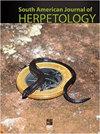Seasonal Reproductive Dynamics of a Lek-Breeding Neotropical Treefrog is not Organized by Male Size (Anura, Hylidae)
IF 0.7
4区 生物学
Q4 ZOOLOGY
引用次数: 2
Abstract
Abstract. Social structure in anurans is directly related to reproductive traits such as chorus organization, male territoriality, pair formation, breeding site choice, and temporal breeding pattern. The Neotropical treefrog Dendropsophus sanborni is an excellent model for studies on reproductive dynamics because it is a prolonged-breeder and usually occurs in high densities. Here, our goals were to better understand the factors that lead to social organization and influence seasonal reproductive dynamics of males of the species. We addressed the hypotheses that (1) the seasonal dynamics of D. sanborni is locally delimited by climatic conditions throughout its breeding season and (2) territorial males are structured spatially and temporally based on body size. We carried out monthly field sampling between October 2015 and September 2016 in an ecotone region of Brazil that originally comprised Semideciduous Seasonal Forest and Cerrado (savannah vegetation). We specifically analyzed environmental conditions, population abundance, size of calling males, and microhabitat use. Our results showed that environmental conditions drive the seasonal reproductive pattern and social structure of calling males is not organized by size. We did not find significant variation in male size among months of the breeding season or among perch heights and types. Our findings suggest a prolonged seasonal reproductive pattern associated with climatic factors without a social structure based on body size.Lek繁殖的季节性繁殖动态新热带Treefrog不是由雄性大小组织的(Anura,Hylidae)
摘要无尾动物的社会结构直接关系到群居组织、雄性领地、配偶形成、繁殖地点选择和繁殖时间模式等生殖特征。新热带树蛙是一种长时间繁殖的树蛙,通常以高密度繁殖,是研究繁殖动力学的一个很好的模型。在这里,我们的目标是更好地了解导致社会组织和影响雄性物种的季节性生殖动态的因素。我们提出了以下假设:(1)在整个繁殖季节,当地的气候条件限定了山伯尼的季节动态;(2)领地雄性在空间和时间上是根据体型结构的。2015年10月至2016年9月,我们在巴西的一个过渡带地区进行了每月的实地采样,该地区最初由半落叶季节性森林和塞拉多(草原植被)组成。我们具体分析了环境条件、种群丰度、鸣叫雄性的大小和微生境的使用。研究结果表明,鸣叫雄性的季节性繁殖模式受环境条件的影响,鸣叫雄性的社会结构不是按大小组织的。我们没有发现雄鱼的体型在繁殖季节的月份之间或在鲈鱼的高度和种类之间有显著的变化。我们的研究结果表明,长期的季节性繁殖模式与气候因素有关,而不是基于体型的社会结构。
本文章由计算机程序翻译,如有差异,请以英文原文为准。
求助全文
约1分钟内获得全文
求助全文
来源期刊
CiteScore
1.50
自引率
0.00%
发文量
10
期刊介绍:
The South American Journal of Herpetology (SAJH) is an international journal published by the Brazilian Society of Herpetology that aims to provide an effective medium of communication for the international herpetological community. SAJH publishes peer-reviewed original contributions on all subjects related to the biology of amphibians and reptiles, including descriptive, comparative, inferential, and experimental studies and taxa from anywhere in the world, as well as theoretical studies that explore principles and methods.

 求助内容:
求助内容: 应助结果提醒方式:
应助结果提醒方式:


